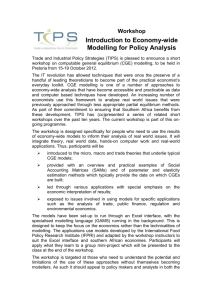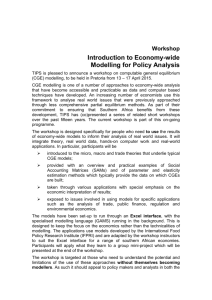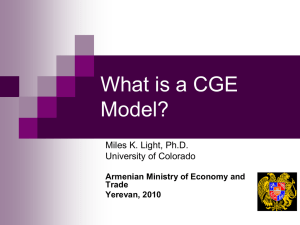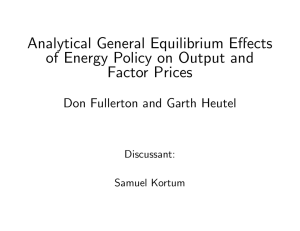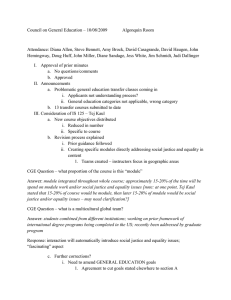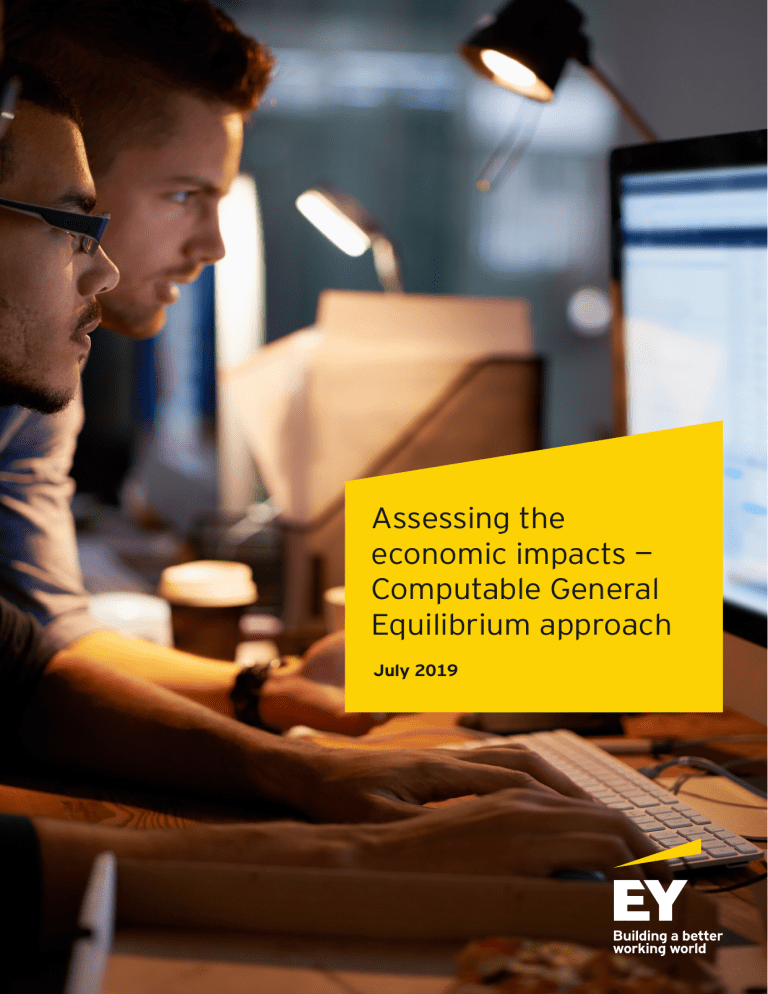
Assessing the economic impacts — Computable General Equilibrium approach July 2019 Contents 1 2 3 4 5 Benefits of general equilibrium analysis page 1 What issues could it be applied to? page 2 What are our capabilities? page 3 Case studies page 4 Our dedicated team page 5 Assessing the economic impacts — Computable General Equilibrium approach 1 Benefits of general equilibrium analysis Businesses, economies and industries operate in an increasingly uncertain and rapidly changing environment: ►► Technological disruption and innovation are transforming supply chains and driving productivity changes. ►► Trade relationships between nations are being reconsidered. ►► Changing economic policies and regulation are reshaping the business landscape. Businesses and governments find themselves under increased scrutiny and growing pressure to make decisions based on robust evidence and credible economic modelling approaches. Many conventional economic methodologies based on static linear analysis (e.g., the multiplier approach) cannot capture the dynamics of ongoing transformation and the increased interconnectivity of industries. Some of these limitations can be addressed by using general equilibrium analysis. Computable General Equilibrium (CGE) models are a class of large-scale models describing an economy as a whole and interactions among its parts. CGE modelling improves the credibility of economic analysis and offers a range of benefits: Is widely accepted and used by governments and multinational institutions such as WTO, UN, and EC Can be tailored to focus on the sector or market of most interest Captures the complexity and interconnectivity of the economy, and knock-on effects between its parts Includes capacity constraints in the economy, resulting in realistic impacts Assessing the economic impacts — Computable General Equilibrium approach | 1 What issues could it be applied to? 2 | Assessing the economic impacts — Computable General Equilibrium approach 2 ►► Effects of changes in tax rates on production and consumption in the economy ►► Modelling impacts of changes in import tariff and export taxes on international trade ►► Economic impacts of disruption to key sectors, e.g., transport and energy infrastructure ►► Impacts of a change in world prices on the domestic economy, e.g., reduction in oil prices ►► Analysis of environmental implications of economic policies ►► Economic implications of public healthcare investment ►► Impacts of economic policies on employment and skills structure What are our capabilities? 3 Global CGE model UK CGE model ►► Our Global CGE tool can be used to model both cross- ►► This is a multisector dynamic CGE model, which has been border impacts related to international trade and impacts of policy changes on individual economies. ►► The Global CGE model relies on a database, which provides a consistent representation of the world economy. ►► The Global CGE model database has a detailed sectoral and country breakdown, which allows us to model impacts on many individual economies and industries. ►► It can be extended to include detailed applications, created specifically for the analysis of the UK economy. ►► This is a dynamic CGE model and therefore can show the evolution of the economy year-by-year, following a policy change until the new equilibrium is reached. ►► The data can be broken down by over 100 sectors, providing rich sectoral detail of the economic impacts. This allows us to tailor the modelling to very specific sectors of the UK economy. for example, in the areas of energy, climate change, migration, and supply chain analysis. … an economy that starts and finishes in equilibrium … What is a CGE model? Computable: CGE models are a class of large-scale models describing an economy as a whole and interactions among its parts. This class of models is used to quantify the outcomes of various ‘what if’ scenarios. General: CGE models are comprehensive, because they describe all parts of the economy simultaneously and how these parts interact with each other. They combine the supplychain of production with consumer demand, government taxes and spending, and external trade. Equilibrium: They model an economy that starts and finishes in equilibrium — thus in model simulations any displaced productive resources (labour and capital) are put back to work in other sectors of the economy, and growth in the overall economy is constrained by the available productive resources. These properties contrast with those of partial equilibrium models, which describe one sector only, while assuming that the rest of the economy does not change. CGE models are attractive to policy makers as they fit with most governments’ and multinational organisations’ core view of how economies work. Assessing the economic impacts — Computable General Equilibrium approach | 3 4 Case studies 1 2 3 4 Economic policy International trade Transport infrastructure Energy EY has performed a number of studies to estimate, using CGE modelling, the impacts of proposed tax policy reforms in the telecommunications sector of a number of developing and emerging economies. EY was commissioned to carry out a study to estimate the impacts of potential additional border controls on trade flows via main UK ports and the wider European economy. In 2014, the UK’s Airports Commission considered the impact of different options of airport expansion in South-East England. EY was commissioned to estimate how Brexit would affect the economic case for the expansion. EY was commissioned to carry out a study to estimate the economic impacts of a prospective project of an interconnector between two European countries. The analysis has provided the client with credible evidence to advocate for changes to the economic policies. The client has used the studies to inform its advocacy strategy and support its engagement with government and private stakeholders. 4 The findings, informed by CGE modelling, have contributed to a better understanding of the impacts of potential longer border controls and increased uncertainty around journey times on international trade and the wider economy and have been used by the client to engage with policymakers and other stakeholders. | Assessing the economic impacts — Computable General Equilibrium approach EY analysis, using the CGE model of the UK economy, has enabled the client to understand how passenger forecasts could change following Brexit, driving changes in tourism expenditure, productivity, foreign trade, and the wider economy. The study, involving CGE modelling, has shown how lower energy prices and enhanced ability to trade electricity would affect other industries and the wider economy. EY analysis has supported the economic case for the project, by demonstrating its long-term benefits for consumers and businesses. 5 Our dedicated team We have an experienced CGE modelling team in the UK Peter Arnold Nick Catton Peter is a Partner in EY’s Economic Advisory team and leads on economic policy. He has over 20 years’ experience advising companies on issues relating to economic policy, regulation, and competition. He provides expert oversight on CGE analysis performed by the team. Nick has over 20 years’ experience working as an economist in the UK Government, including overseeing the development of HMT’s CGE model. He has a wide range of experience in economic analysis, and has led numerous EY CGE modelling engagements. Partner Assistant Director + 44 20 7951 2213 ncatton@uk.ey.com + 44 20 7951 5587 parnold@uk.ey.com Ade Adeniji-Adele Andrei Viacherski Assistant Director Manager Ade has over 10 years’ experience leading projects involving financial and economic analysis and modelling, economic impact analysis, regulatory analysis, costing and economic forecasting. He has completed applied training in CGE analysis and modelling. Andrei has more than 9 years’ experience in economic policy analysis. He has used CGE modelling for a range of projects in tax policy and international trade areas. He has completed applied training in CGE analysis and modelling. + 44 20 7806 9304 aadeniji-adele@uk.ey.com + 44 20 7197 7001 aviacherski@uk.ey.com Eleonora Loureiro Tim Berry Executive Analyst Eleonora has over 8 years’ experience in economic analysis, including econometric modelling, impact assessments, and macroeconomic forecasting. She has completed applied training in CGE analysis and modelling. Tim is an Analyst in the Economic Advisory team. He has experience on a range of projects around policy analysis and modelling. He applied CGE models in a range of tax and energy policy projects. He has completed applied training in CGE analysis and modelling. + 44 20 7951 8698 eleonora.loureiro@uk.ey.com + 44 20 7197 9020 tberry@uk.ey.com We also have dedicated CGE teams in Australia and MENA ►► Trade policy analysis ►► Tax policy analysis ►► Workforce modelling ►► Energy modelling ►► Infrastructure modelling ►► Health modelling Jiao Wang Associate Director, EY Canberra + 61 2 6246 1557 jiao.wang@au.ey.com Maxime Clemenceau Manager, EY Dubai + 97 1505 164514 maxime.clemenceau@ae.ey.com Assessing the economic impacts — Computable General Equilibrium approach | 5 EY | Assurance | Tax | Transactions | Advisory About EY EY is a global leader in assurance, tax, transaction and advisory services. The insights and quality services we deliver help build trust and confidence in the capital markets and in economies the world over. We develop outstanding leaders who team to deliver on our promises to all of our stakeholders. In so doing, we play a critical role in building a better working world for our people, for our clients and for our communities. EY refers to the global organization, and may refer to one or more, of the member firms of Ernst & Young Global Limited, each of which is a separate legal entity. Ernst & Young Global Limited, a UK company limited by guarantee, does not provide services to clients. For more information about our organization, please visit ey.com. Ernst & Young LLP The UK firm Ernst & Young LLP is a limited liability partnership registered in England and Wales with registered number OC300001 and is a member firm of Ernst & Young Global Limited. Ernst & Young LLP, 1 More London Place, London, SE1 2AF. © 2019 Ernst & Young LLP. Published in the UK. All Rights Reserved. ED None EY-000099451.indd (UK) 07/19. Artwork by Creative Services Group London. In line with EY’s commitment to minimise its impact on the environment, this document has been printed on paper with a high recycled content. Information in this publication is intended to provide only a general outline of the subjects covered. It should neither be regarded as comprehensive nor sufficient for making decisions, nor should it be used in place of professional advice. Ernst & Young LLP accepts no responsibility for any loss arising from any action taken or not taken by anyone using this material. ey.com/uk
